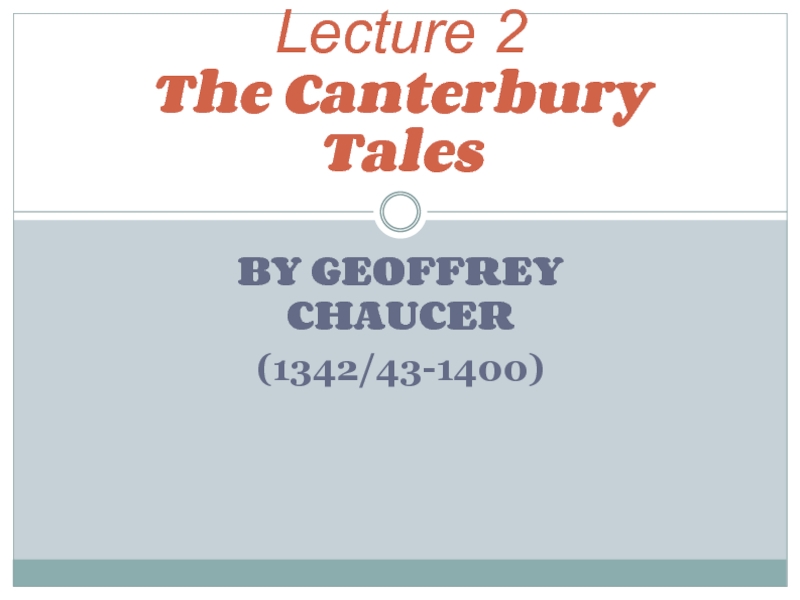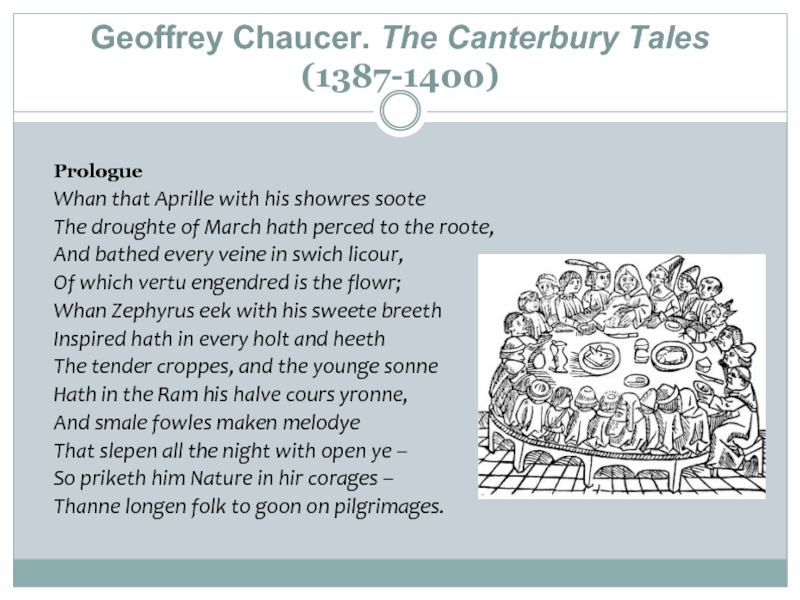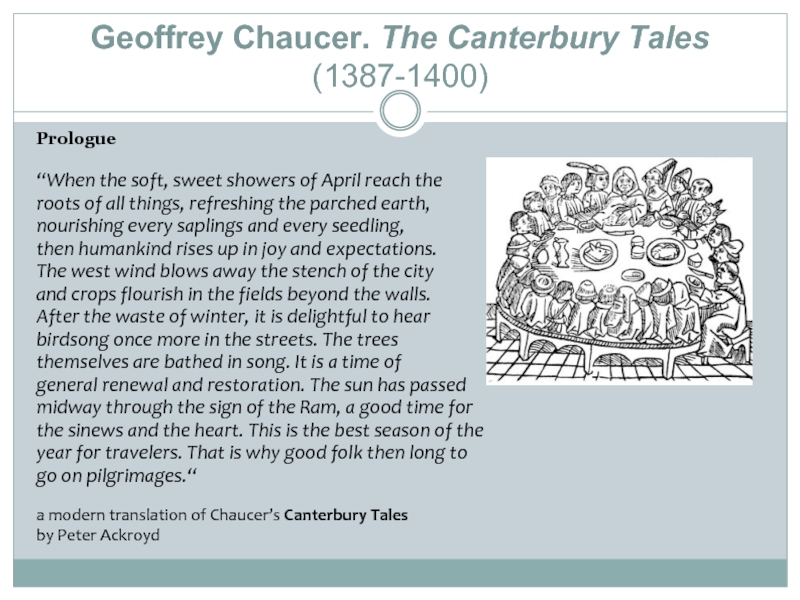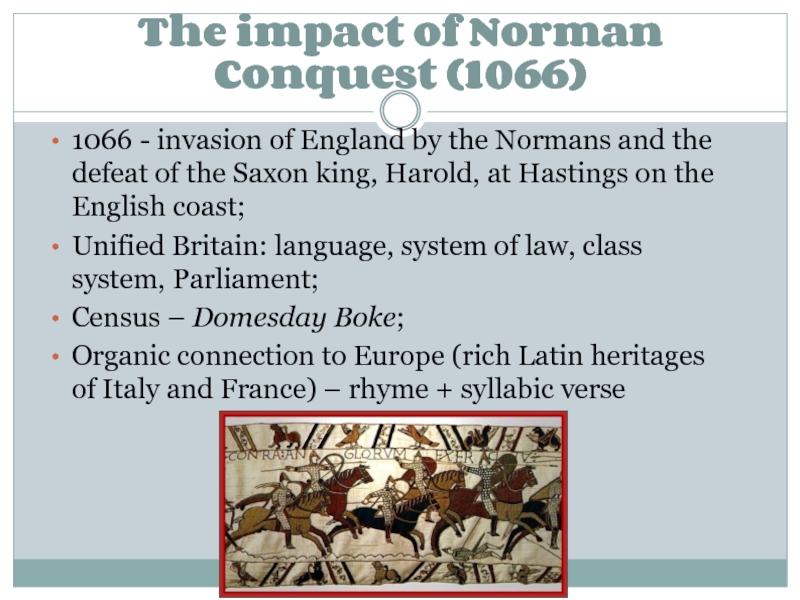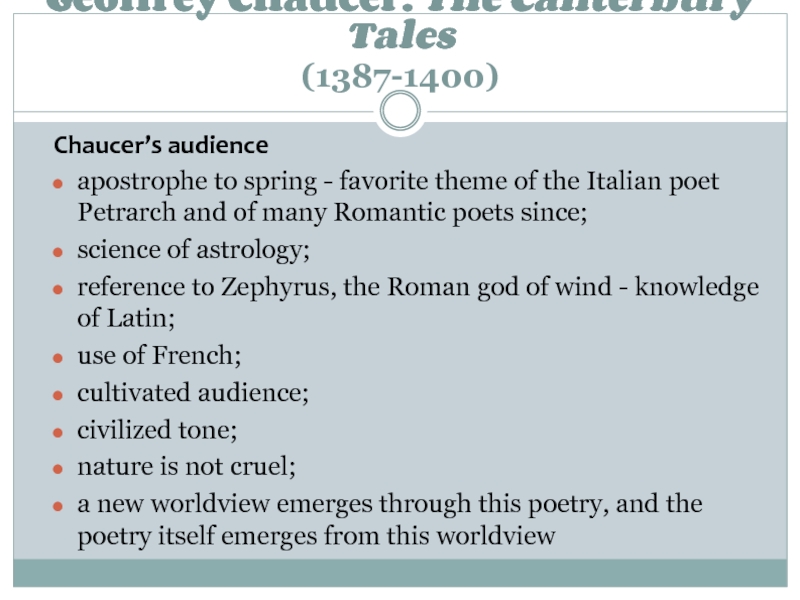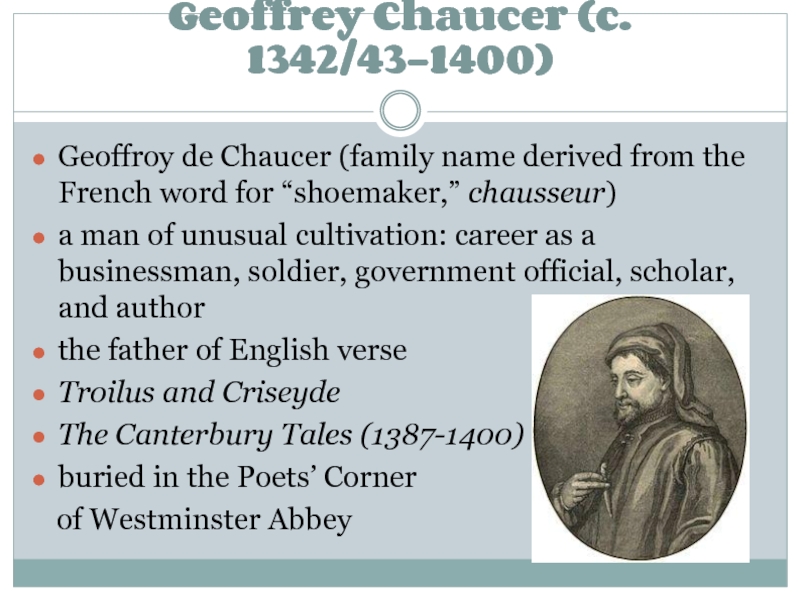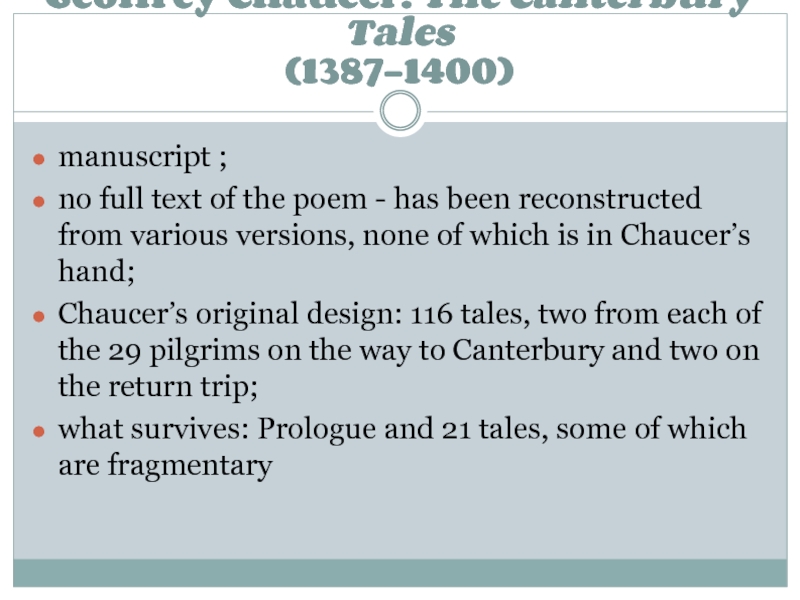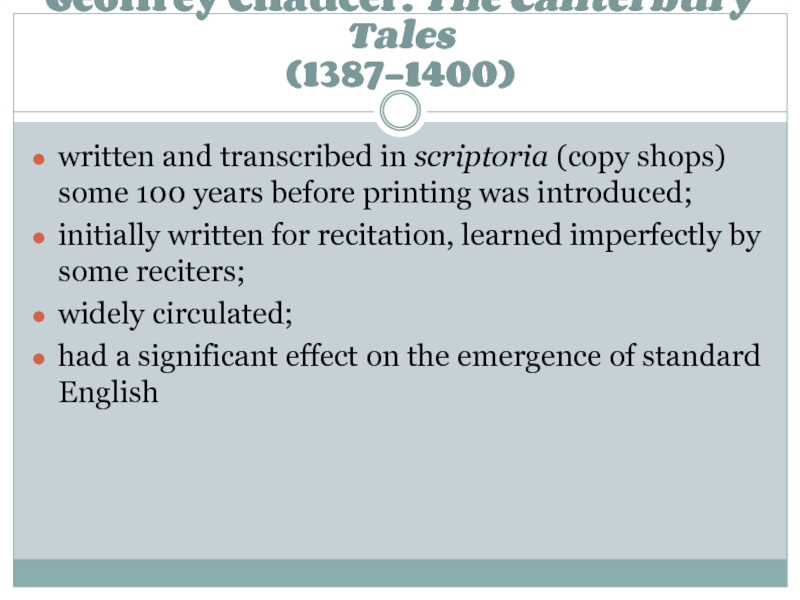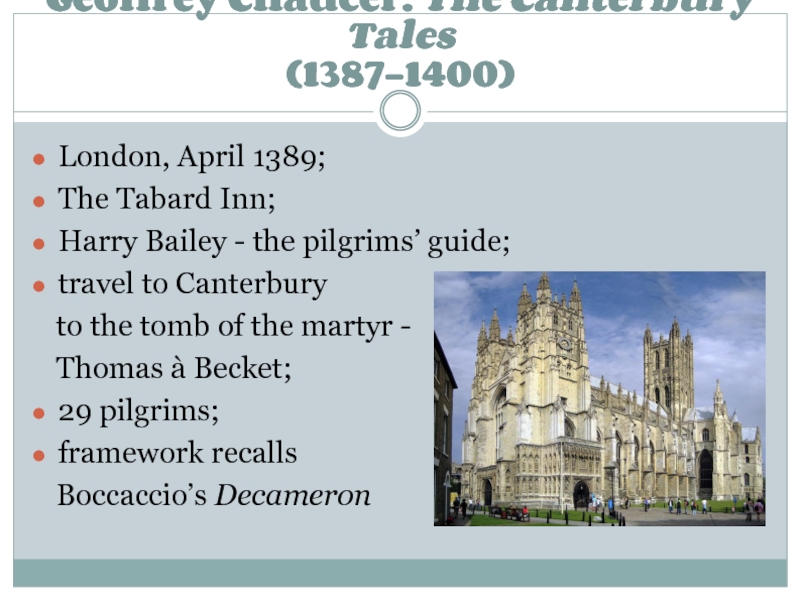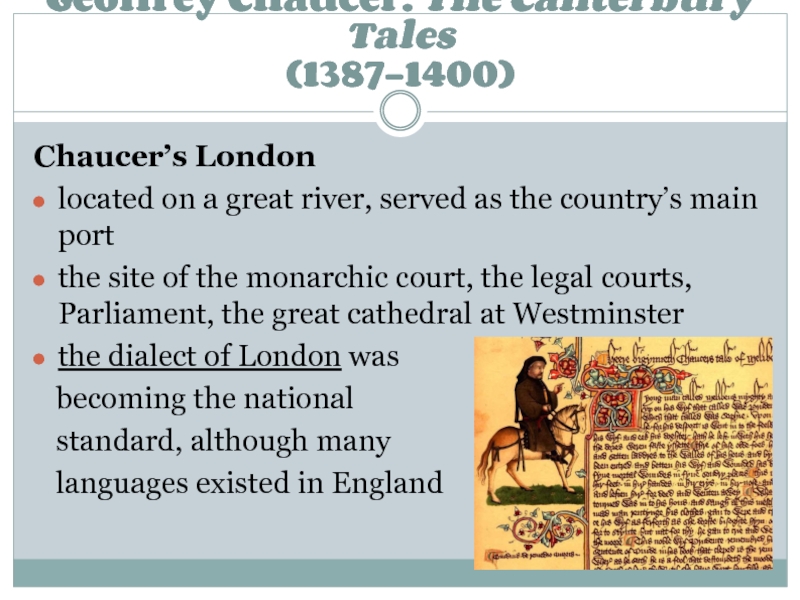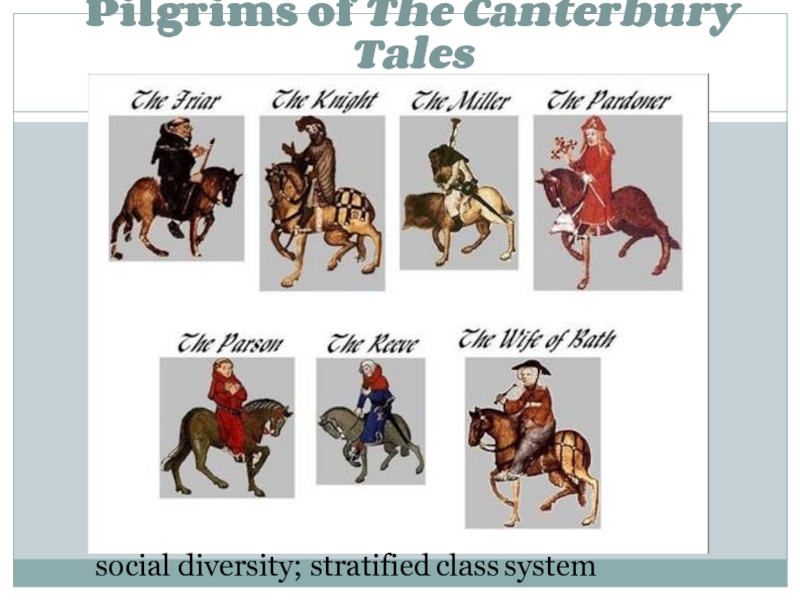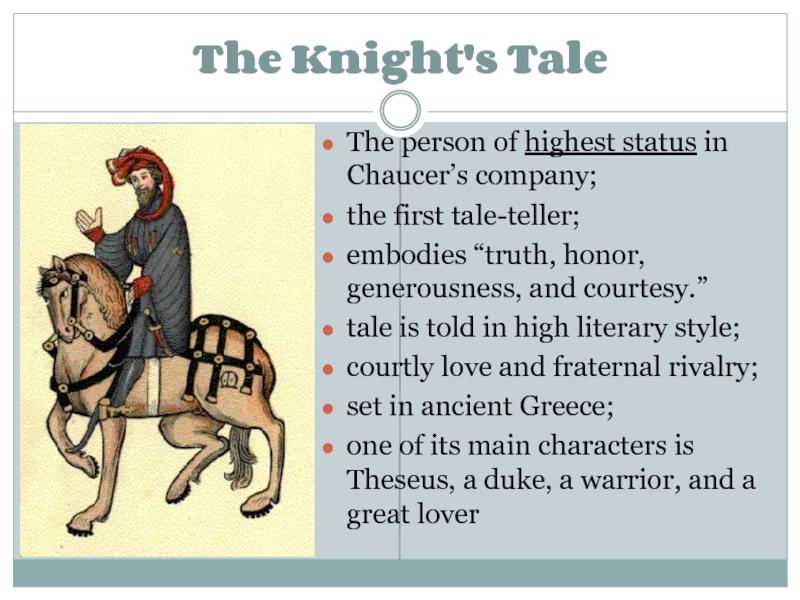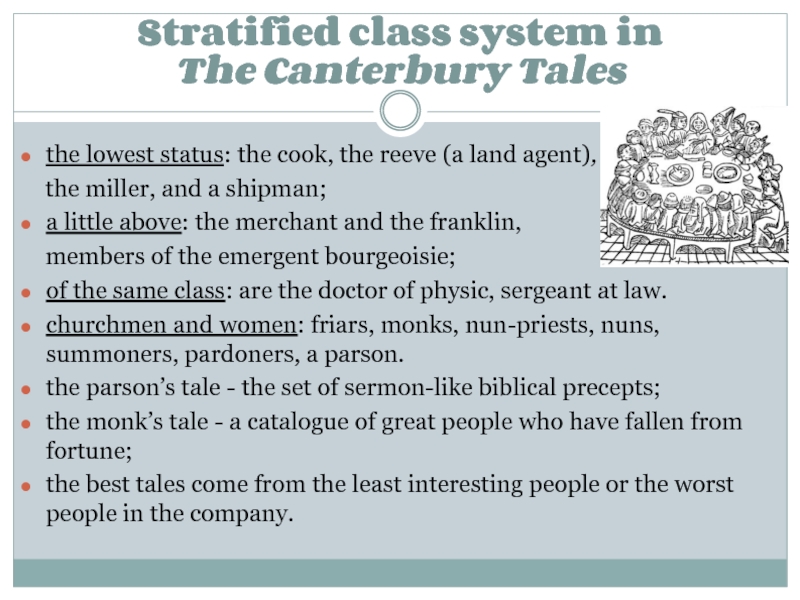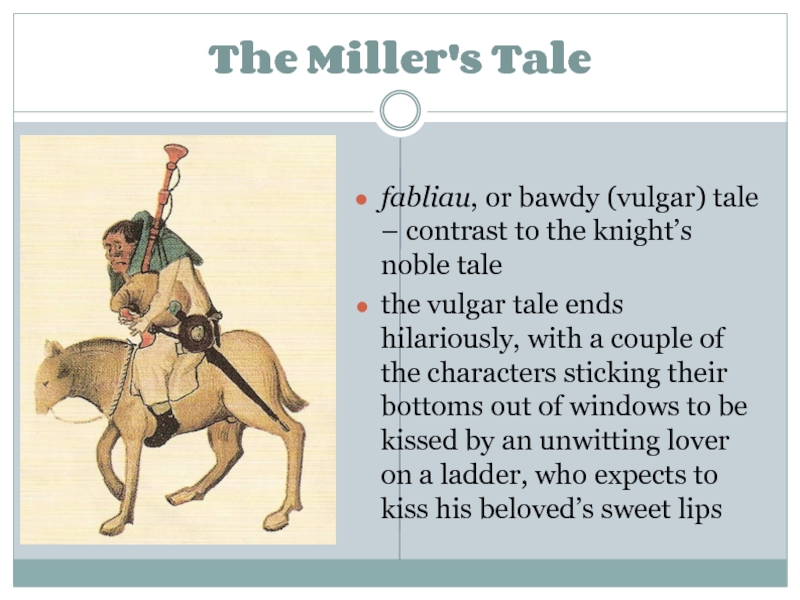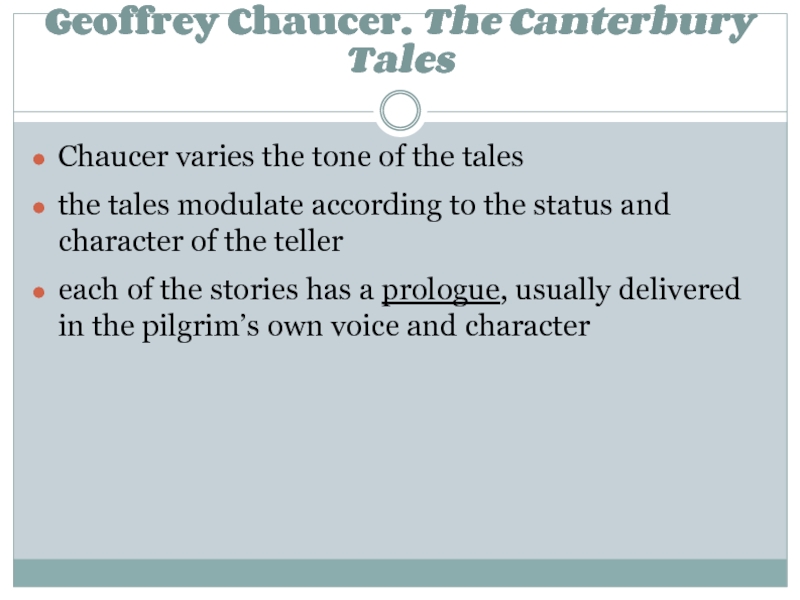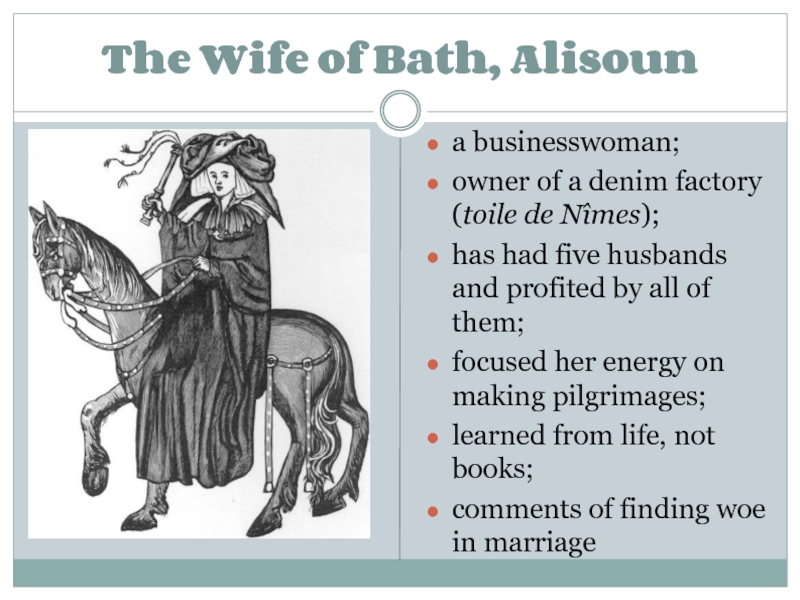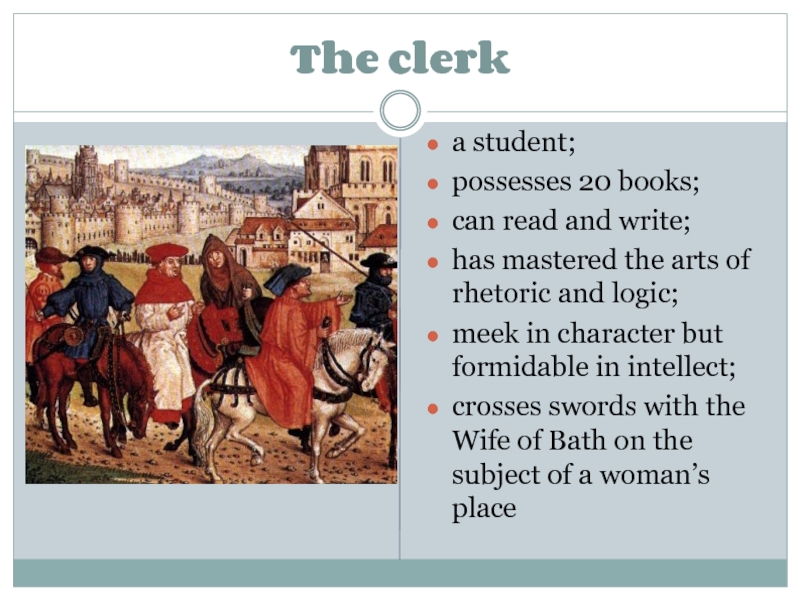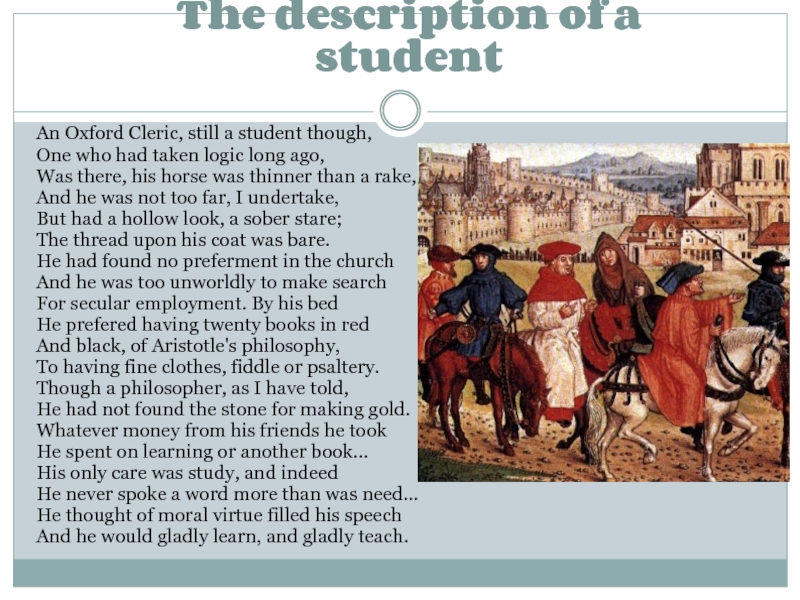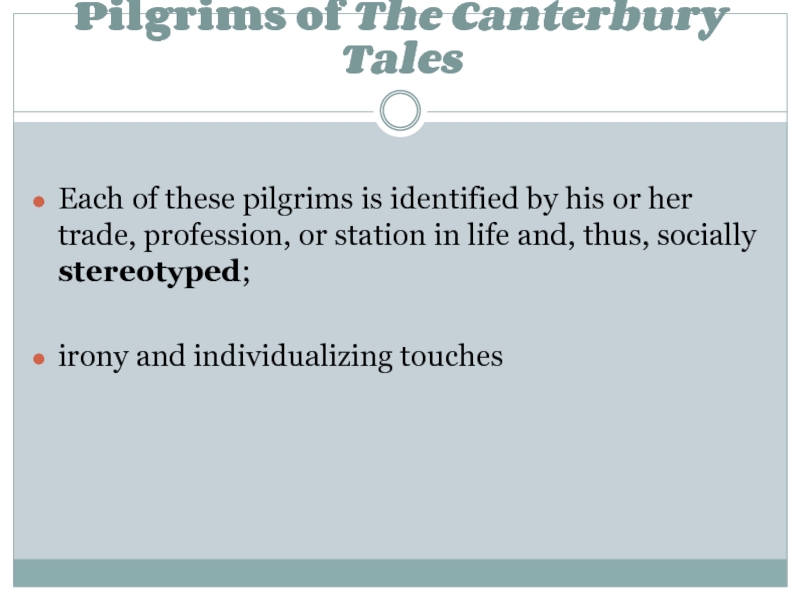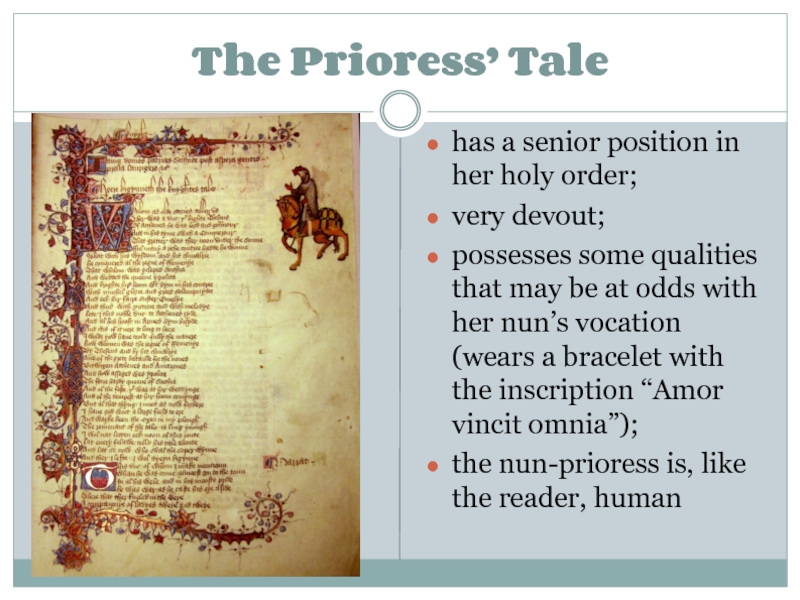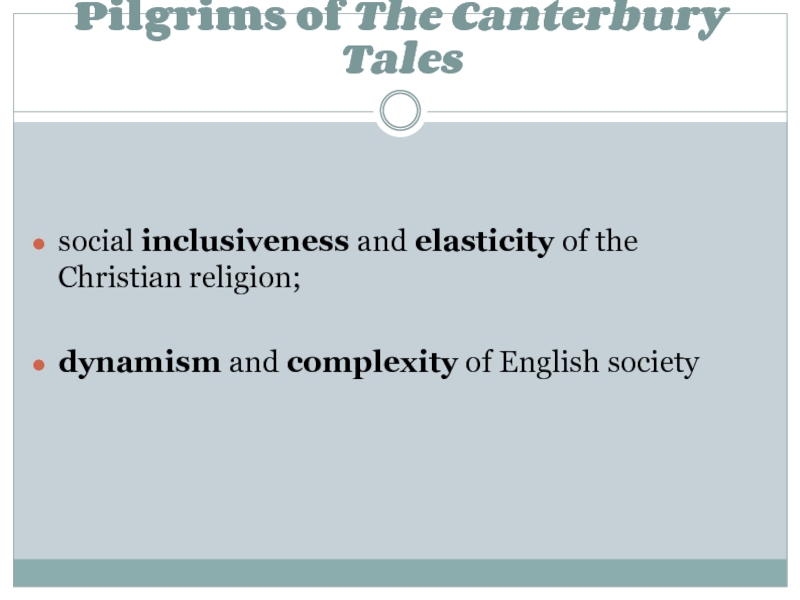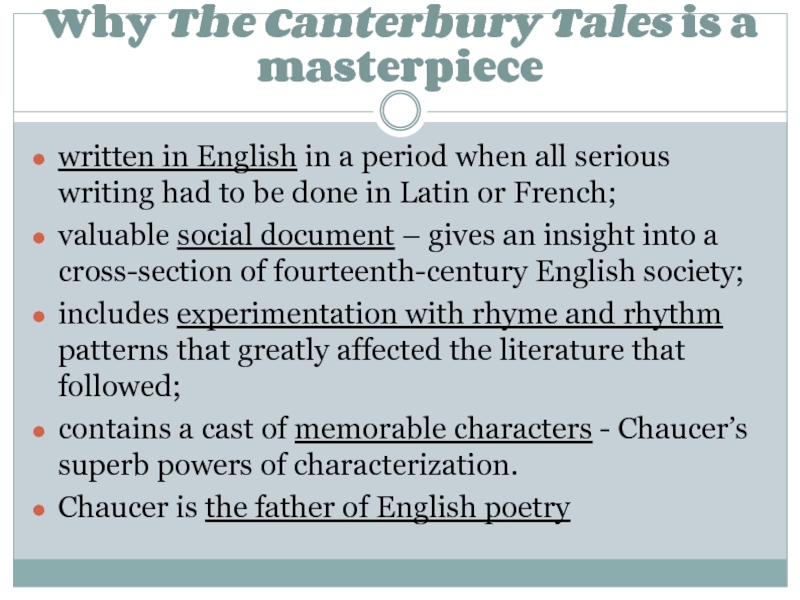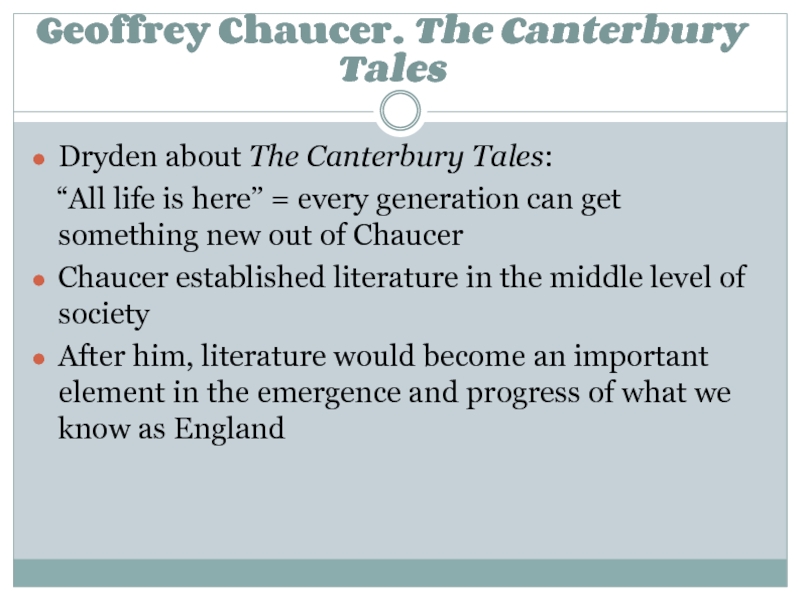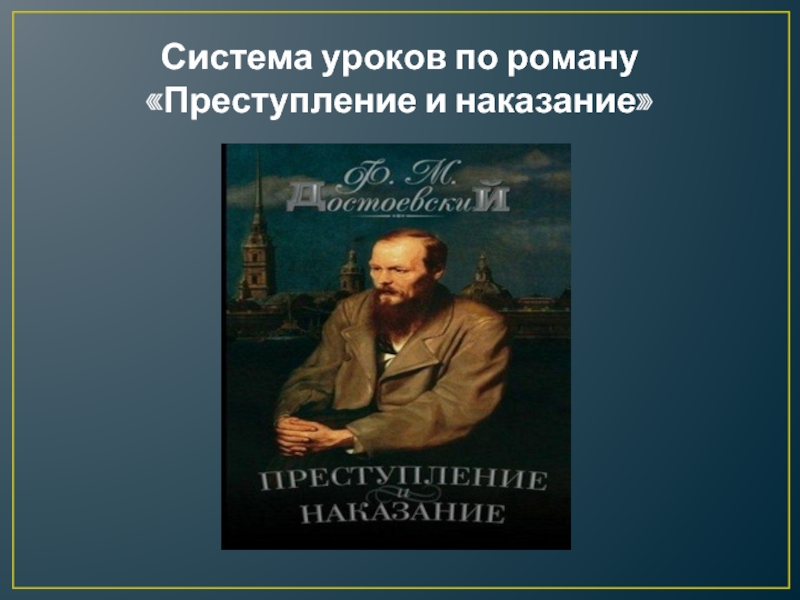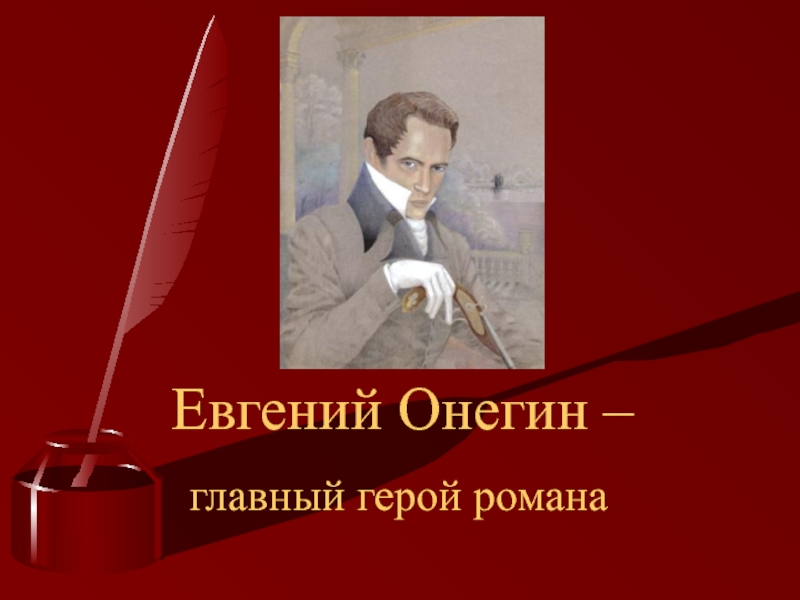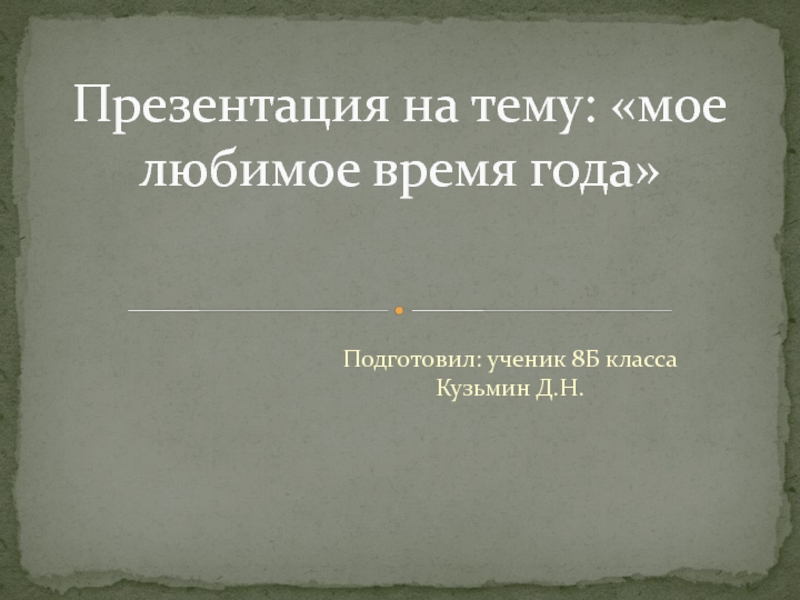- Главная
- Разное
- Дизайн
- Бизнес и предпринимательство
- Аналитика
- Образование
- Развлечения
- Красота и здоровье
- Финансы
- Государство
- Путешествия
- Спорт
- Недвижимость
- Армия
- Графика
- Культурология
- Еда и кулинария
- Лингвистика
- Английский язык
- Астрономия
- Алгебра
- Биология
- География
- Детские презентации
- Информатика
- История
- Литература
- Маркетинг
- Математика
- Медицина
- Менеджмент
- Музыка
- МХК
- Немецкий язык
- ОБЖ
- Обществознание
- Окружающий мир
- Педагогика
- Русский язык
- Технология
- Физика
- Философия
- Химия
- Шаблоны, картинки для презентаций
- Экология
- Экономика
- Юриспруденция
Lecture 2. The Canterbury Tales by Geoffrey Chaucer презентация
Содержание
- 1. Lecture 2. The Canterbury Tales by Geoffrey Chaucer
- 2. Geoffrey Chaucer. The Canterbury Tales (1387-1400)
- 3. Prologue “When the soft, sweet showers
- 4. The impact of Norman Conquest (1066) 1066
- 5. Chaucer’s audience apostrophe to spring - favorite
- 6. Geoffrey Chaucer (c. 1342/43-1400) Geoffroy de Chaucer
- 7. manuscript ; no full text of the
- 8. written and transcribed in scriptoria (copy shops)
- 9. London, April 1389; The Tabard Inn; Harry
- 10. Chaucer’s London located on a great river,
- 11. Pilgrims of The Canterbury Tales social diversity; stratified class system
- 12. The Knight's Tale The person of highest
- 13. the lowest status: the cook, the reeve
- 14. The Miller's Tale fabliau, or bawdy (vulgar)
- 15. Chaucer varies the tone of the tales
- 16. The Wife of Bath, Alisoun a businesswoman;
- 17. The clerk a student; possesses 20 books;
- 18. The description of a student An Oxford
- 19. Pilgrims of The Canterbury Tales Each
- 20. The Prioress’ Tale has a senior position
- 21. Pilgrims of The Canterbury Tales
- 22. Why The Canterbury Tales is a masterpiece
- 23. Dryden about The Canterbury Tales:
Слайд 2Geoffrey Chaucer. The Canterbury Tales
(1387-1400)
Prologue
Whan that Aprille with his showres
The droughte of March hath perced to the roote,
And bathed every veine in swich licour,
Of which vertu engendred is the flowr;
Whan Zephyrus eek with his sweete breeth
Inspired hath in every holt and heeth
The tender croppes, and the younge sonne
Hath in the Ram his halve cours yronne,
And smale fowles maken melodye
That slepen all the night with open ye –
So priketh him Nature in hir corages –
Thanne longen folk to goon on pilgrimages.
Слайд 3Prologue
“When the soft, sweet showers of April reach the
roots of all
nourishing every saplings and every seedling,
then humankind rises up in joy and expectations.
The west wind blows away the stench of the city
and crops flourish in the fields beyond the walls.
After the waste of winter, it is delightful to hear
birdsong once more in the streets. The trees
themselves are bathed in song. It is a time of
general renewal and restoration. The sun has passed
midway through the sign of the Ram, a good time for
the sinews and the heart. This is the best season of the
year for travelers. That is why good folk then long to
go on pilgrimages.“
a modern translation of Chaucer’s Canterbury Tales
by Peter Ackroyd
Geoffrey Chaucer. The Canterbury Tales
(1387-1400)
Слайд 4The impact of Norman Conquest (1066)
1066 - invasion of England by
Unified Britain: language, system of law, class system, Parliament;
Census – Domesday Boke;
Organic connection to Europe (rich Latin heritages of Italy and France) – rhyme + syllabic verse
Слайд 5Chaucer’s audience
apostrophe to spring - favorite theme of the Italian poet
science of astrology;
reference to Zephyrus, the Roman god of wind - knowledge of Latin;
use of French;
cultivated audience;
civilized tone;
nature is not cruel;
a new worldview emerges through this poetry, and the poetry itself emerges from this worldview
Geoffrey Chaucer. The Canterbury Tales
(1387-1400)
Слайд 6Geoffrey Chaucer (c. 1342/43-1400)
Geoffroy de Chaucer (family name derived from the
a man of unusual cultivation: career as a businessman, soldier, government official, scholar, and author
the father of English verse
Troilus and Criseyde
The Canterbury Tales (1387-1400)
buried in the Poets’ Corner
of Westminster Abbey
Слайд 7manuscript ;
no full text of the poem - has been reconstructed
Chaucer’s original design: 116 tales, two from each of the 29 pilgrims on the way to Canterbury and two on the return trip;
what survives: Prologue and 21 tales, some of which are fragmentary
Geoffrey Chaucer. The Canterbury Tales
(1387-1400)
Слайд 8written and transcribed in scriptoria (copy shops) some 100 years before
initially written for recitation, learned imperfectly by some reciters;
widely circulated;
had a significant effect on the emergence of standard English
Geoffrey Chaucer. The Canterbury Tales
(1387-1400)
Слайд 9London, April 1389;
The Tabard Inn;
Harry Bailey - the pilgrims’ guide;
travel
to the tomb of the martyr -
Thomas à Becket;
29 pilgrims;
framework recalls
Boccaccio’s Decameron
Geoffrey Chaucer. The Canterbury Tales
(1387-1400)
Слайд 10Chaucer’s London
located on a great river, served as the country’s main
the site of the monarchic court, the legal courts, Parliament, the great cathedral at Westminster
the dialect of London was
becoming the national
standard, although many
languages existed in England
Geoffrey Chaucer. The Canterbury Tales
(1387-1400)
Слайд 12The Knight's Tale
The person of highest status in Chaucer’s company;
the first
embodies “truth, honor, generousness, and courtesy.”
tale is told in high literary style;
courtly love and fraternal rivalry;
set in ancient Greece;
one of its main characters is Theseus, a duke, a warrior, and a great lover
Слайд 13the lowest status: the cook, the reeve (a land agent),
a little above: the merchant and the franklin,
members of the emergent bourgeoisie;
of the same class: are the doctor of physic, sergeant at law.
churchmen and women: friars, monks, nun-priests, nuns, summoners, pardoners, a parson.
the parson’s tale - the set of sermon-like biblical precepts;
the monk’s tale - a catalogue of great people who have fallen from fortune;
the best tales come from the least interesting people or the worst people in the company.
Stratified class system in
The Canterbury Tales
Слайд 14The Miller's Tale
fabliau, or bawdy (vulgar) tale – contrast to the
the vulgar tale ends hilariously, with a couple of the characters sticking their bottoms out of windows to be kissed by an unwitting lover on a ladder, who expects to kiss his beloved’s sweet lips
Слайд 15Chaucer varies the tone of the tales
the tales modulate according to
each of the stories has a prologue, usually delivered in the pilgrim’s own voice and character
Geoffrey Chaucer. The Canterbury Tales
Слайд 16The Wife of Bath, Alisoun
a businesswoman;
owner of a denim factory (toile
has had five husbands and profited by all of them;
focused her energy on making pilgrimages;
learned from life, not books;
comments of finding woe in marriage
Слайд 17The clerk
a student;
possesses 20 books;
can read and write;
has mastered the arts
meek in character but formidable in intellect;
crosses swords with the Wife of Bath on the subject of a woman’s place
Слайд 18The description of a student
An Oxford Cleric, still a student though,
One
Was there, his horse was thinner than a rake,
And he was not too far, I undertake,
But had a hollow look, a sober stare;
The thread upon his coat was bare.
He had found no preferment in the church
And he was too unworldly to make search
For secular employment. By his bed
He prefered having twenty books in red
And black, of Aristotle's philosophy,
To having fine clothes, fiddle or psaltery.
Though a philosopher, as I have told,
He had not found the stone for making gold.
Whatever money from his friends he took
He spent on learning or another book...
His only care was study, and indeed
He never spoke a word more than was need...
He thought of moral virtue filled his speech
And he would gladly learn, and gladly teach.
Слайд 19Pilgrims of The Canterbury Tales
Each of these pilgrims is identified by
irony and individualizing touches
Слайд 20The Prioress’ Tale
has a senior position in her holy order;
very devout;
possesses
the nun-prioress is, like the reader, human
Слайд 21Pilgrims of The Canterbury Tales
social inclusiveness and elasticity of the Christian
dynamism and complexity of English society
Слайд 22Why The Canterbury Tales is a masterpiece
written in English in a
valuable social document – gives an insight into a cross-section of fourteenth-century English society;
includes experimentation with rhyme and rhythm patterns that greatly affected the literature that followed;
contains a cast of memorable characters - Chaucer’s superb powers of characterization.
Chaucer is the father of English poetry
Слайд 23Dryden about The Canterbury Tales:
“All life is here”
Chaucer established literature in the middle level of society
After him, literature would become an important element in the emergence and progress of what we know as England
Geoffrey Chaucer. The Canterbury Tales
